Michigan State was going to lose, but 6-foot-5 Coen Carr was still hustling. He rushed through the lane, passing three Auburn players to fight for a rebound. Auburn’s Miles Kelly slapped the ball out of his hands, and the two ended up on the ground fighting for it. Eventually, Kelly and MSU’s Jase Richardson had dual possession. The referees signaled for a jump ball.
Because this was college basketball, that did not lead to an actual jump ball. Auburn got the ball because the possession arrow was in their favor, something the Tigers had because they won the opening tip. The possession arrow wasn’t needed in the first half, and so Michigan State inbounded the ball to begin the second. Auburn then had the possession arrow in its favor for the entire second half. Nearly 20 minutes later, that meant they got the ball after that late tie-up.
Beyond the unnecessary misnomer aspect of all this: Blech. Carr came through and made a nice play. Kelly ended up with the ball, but Richardson tied him up before he could make a pass. Michigan State’s hustle in the face of certain defeat was rewarded like this: The other team got the ball, and the Spartans could play the next 26.6 seconds of a game they were losing by nine points secure in the knowledge that the possession arrow was now in their favor. Wouldn’t it be more fair, and more fun, if Kelly and Richardson had jumped it up at that point?
There used to be a lot more jump balls in basketball. Before the 1975-76 season the NBA eliminated the jumps that once started the second and fourth quarters. Some college conferences experimented with a possession arrow in the late 1970s, eliminating jump balls after tie-ups. “The jump ball rule is ridiculous,” Bobby Knight said at the time, “and if anybody understands it, he should command the next space flight.”
The ACC tried out a possession arrow during the 1978-79 season. NC State coach Jim Sloan voted for it, and by February he had regrets: “It just doesn’t seem natural,” Sloan said. “We’ve just made a mistake. We’ve lost something in the game. I haven’t found a fan yet who likes it.” Stan Murray, the sports editor for Utah’s The Daily Spectrum, wrote the rule belonged in playground basketball.
There were a few stated reasons for the change. One was the thinking that it would speed up the game; players at the time tended to stall before the jump. NCAA rule-makers also basically admitted that officials couldn’t really do their jobs properly. It was hard for them to throw the ball straight up consistently, and the refs couldn’t keep track of the other eight players during a jump. Longtime Louisville coach Denny Crum reminisced about referee incompetence back in 1999: “You’d have four or five jumps and in any one given game the ball might be three inches to the left or right and give some guy an advantage.”
North Carolina’s Dean Smith said that shorter guys would consistently try to jump early in mismatches, and a possession arrow was “a very fair method.” Virginia coach Terry Holland concurred, saying violations during jump balls went uncalled “60 to 70 percent” of the time. “They can drop it from the scoreboard or put it in the middle of the floor, that’s OK,” he said. “I don’t think we should have jump balls.”
The NCAA instituted the possession arrow nationwide in 1981. It would be used for held balls, free throw violations, technical fouls when neither team is in control of the ball, and times when the ball gets wedged between the backboard and rim.
Retired Marquette coach Al McGuire said the rule change had worldwide repercussions: “Whenever they took a basketball picture to send to New Zealand or someplace to show them what basketball was all about, they always took a shot of a jump ball,” he said. “Now what are they going to do?” FIBA now ranks New Zealand 22nd in the world in basketball, so those jump ball photos must’ve already made it there before the rule change.
It seems unlikely New Zealand suffered much due to the rule change, and it doesn’t seem quite right to say that the jump ball is “what basketball is all about.” But is the possession arrow really the solution to the game flow and reffing issues that the proliferation of jump balls once caused? Is it more fair than having the ref occasionally toss the ball slightly in one team’s direction? Can’t refs more easily track the other eight players now, since there have been three officials instead of two on the floor since the late 1980s? More to the point, how is it fair that a team could play fantastic defense and tie up the ball, and still have their opponents keep possession because the ball got stuck between the backboard and rim earlier in the half?
In 1998 the NCAA tweaked the rule, giving the defense the ball on a tie-up no matter which team had the possession arrow. But a lot of coaches hated the change, and the rule was abandoned after one season. Jump balls made a return as part of a rules experiment at a November 2001 Coaches vs. Cancer tournament, but there was little support among coaches for changing the rule. No word on how cancer felt about it.
All of which means that college basketball is stuck with the possession arrow. Maybe it speeds up the game a little. Maybe it saves us from incompetent refereeing. And maybe this solution is still superior to the problem it solved. It still sucks.






